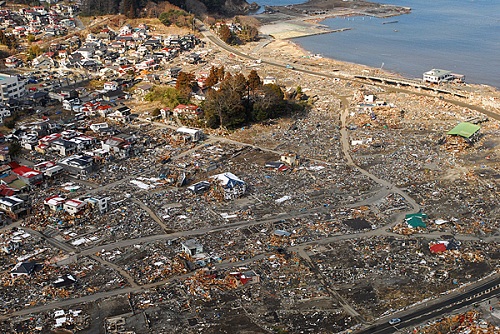ACADEMIA
Stanford scientists' supercomputer models help predict tsunami risk
When a magnitude 9.0 earthquake struck off the coast of Japan in March, it triggered a tsunami that killed more than 20,000 people and destroyed entire cities. It was the largest earthquake ever recorded in Japan, and the scale of the disaster stunned even geophysicists who specialize in earthquake science.
"In this earthquake it was really surprising that we got such a large seafloor uplift and such a large tsunami," said Eric Dunham, assistant professor of geophysics.
"Before this earthquake, before we had these detailed measurements, it was thought that this upper part of the fault would not slip in one of these large earthquakes.
"The extreme amounts of slip in the upper part of the fault led to a large amount of uplift in the seafloor, and then that uplifted the column of water that sloshed back down and created this large tsunami."
Measurements from the quake zone show that the fault slipped about 20 meters, and the seafloor lifted up about 7 meters.
"This is essentially a third of a football field the plate was displaced horizontally, and the seafloor lifted up about the height of a two-story building," said Jeremy Kozdon, a postdoctoral research fellow who has been working with Dunham to create computational models to pinpoint the cause of the devastating tsunami.{hwdvs-player}id=391|height=240|width=300{/hwdvs-player}
"It was expected that there would be large earthquakes in this region, but it wasn't expected that there would be a magnitude 9.0. And it wasn't expected that there would be a large tsunami, or at least a tsunami of this size."
The undersea mega-thrust earthquake happened off Japan's northeast coast in an area known as a subduction zone, where the Pacific Plate plunges beneath the Japanese islands. The physics-driven supercomputer models suggest that the large seafloor uplift and resulting tsunami were caused when seismic waves from the initial earthquake bounced back down from the seafloor above and caused the plates to slip more than had previously been expected.
"Our models show that as the rupture propagates up the fault, waves reflect off the seafloor [and] come back down to the fault," said Dunham.
"They serve to unclamp the fault, release the pressure that's acting on it and allow it to slip."
The complex computations are run on high-performance parallel supercomputers at Stanford and in Texas.
"To give you a sense of the computational scale of these problems, they take about 30 to 60 hours on a thousand processors," said Kozdon.
"If we were to run this on a single machine, it would take about eight years to do these simulations, whereas we can do them in a day or two."
Dunham and Kozdon wrote specialized supercomputer code, which allows their models to incorporate the changing speed of seismic waves as they travel through different types of rock.
"One of the unique capabilities of our research group is that our code that we've created – and the method that we've developed – is capable of handling these really complex geometries," said Kozdon.
"Waves propagate in these different types of rock and they interact with each other, and that creates really complex wave fields."
The scientists hope these supercomputer models will help to predict where future tsunamis might occur.
"What we found in our simulations, in certain cases, the rupture will actually stop short of the sea floor and that will lead to a smaller tsunami.
"In other cases we've been able to identify the conditions where the rupture can propagate all the way up to the seafloor, cause a large seafloor uplift and cause a large tsunami."
Several tsunami hazard regions are in the United States, including the Cascadia subduction zone off the coast of Washington state. Kozdon said supercomputer simulations like the one they performed on the Tohoku-Oki earthquake in Japan could help assess the tsunami risk associated with those faults.
"We need to be able to do simulations that have as much physics as possible, to really be able to quantify the hazards associated with these earthquakes," said Kozdon.
"We can begin to study these really complex earthquakes in these really complex regions of the world."
